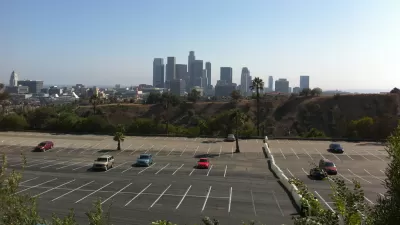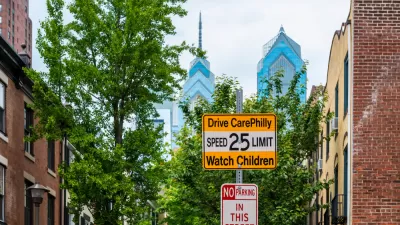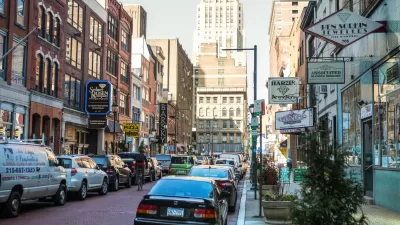Philadelphia's Mayor Michael Nutter has set a policy goal of becoming the "Greenest City in America," but the city's lack of progress in reducing automobile use is a troubling obstacle to such a lofty goal.
"In rather striking contrast with Pittsburgh and other big U.S. cities that have finally begun facing up to the role their auto-oriented planning and policy choices play in the climate challenge, Nutter’s Philadelphia is noteworthy for how little reckoning has taken place, particularly on City Council, and how ineffective policy “carrots” alone are at reducing car use," argues Jonathan Geeting.
Geeting cites a chart meant to tout the success of Philadelphia in reducing driving but finds only greenwashing.
Meanwhile, says Geeting, other cities are doing a much better job: "Over on the other side of Pennsylvania, Pittsburgh has been a national leader in cutting VMT while enjoying a substantially stronger economic recovery than Philadelphia and most of the nation, and Vancouver has overseen traffic declines of 20 percent on its major streets, even as its population has grown 4.5 percent since 2006…The difference is policy… city policy has largely avoided sticks to discourage driving."
Moreover, "[the] Nutter administration’s gains on bike-ped infrastructure are significant compared to the pre-Nutter status quo, and the increases in biking and walking shouldn’t be diminished. But there’s no getting around it: The impact has been weak in the face of Philadelphia’s impressive universe of car subsidies."
The post goes on to detail some of the possibilities for new parking policies and the politics preventing them from moving forward.
FULL STORY: There’s a Car-Sized Hole in Philly’s “Greenest City in America” Plan

Alabama: Trump Terminates Settlements for Black Communities Harmed By Raw Sewage
Trump deemed the landmark civil rights agreement “illegal DEI and environmental justice policy.”

Study: Maui’s Plan to Convert Vacation Rentals to Long-Term Housing Could Cause Nearly $1 Billion Economic Loss
The plan would reduce visitor accommodation by 25% resulting in 1,900 jobs lost.

Why Should We Subsidize Public Transportation?
Many public transit agencies face financial stress due to rising costs, declining fare revenue, and declining subsidies. Transit advocates must provide a strong business case for increasing public transit funding.

Paris Bike Boom Leads to Steep Drop in Air Pollution
The French city’s air quality has improved dramatically in the past 20 years, coinciding with a growth in cycling.

Why Housing Costs More to Build in California Than in Texas
Hard costs like labor and materials combined with ‘soft’ costs such as permitting make building in the San Francisco Bay Area almost three times as costly as in Texas cities.

San Diego County Sees a Rise in Urban Coyotes
San Diego County experiences a rise in urban coyotes, as sightings become prevalent throughout its urban neighbourhoods and surrounding areas.
Urban Design for Planners 1: Software Tools
This six-course series explores essential urban design concepts using open source software and equips planners with the tools they need to participate fully in the urban design process.
Planning for Universal Design
Learn the tools for implementing Universal Design in planning regulations.
Smith Gee Studio
Alamo Area Metropolitan Planning Organization
City of Santa Clarita
Institute for Housing and Urban Development Studies (IHS)
City of Grandview
Harvard GSD Executive Education
Toledo-Lucas County Plan Commissions
Salt Lake City
NYU Wagner Graduate School of Public Service





























